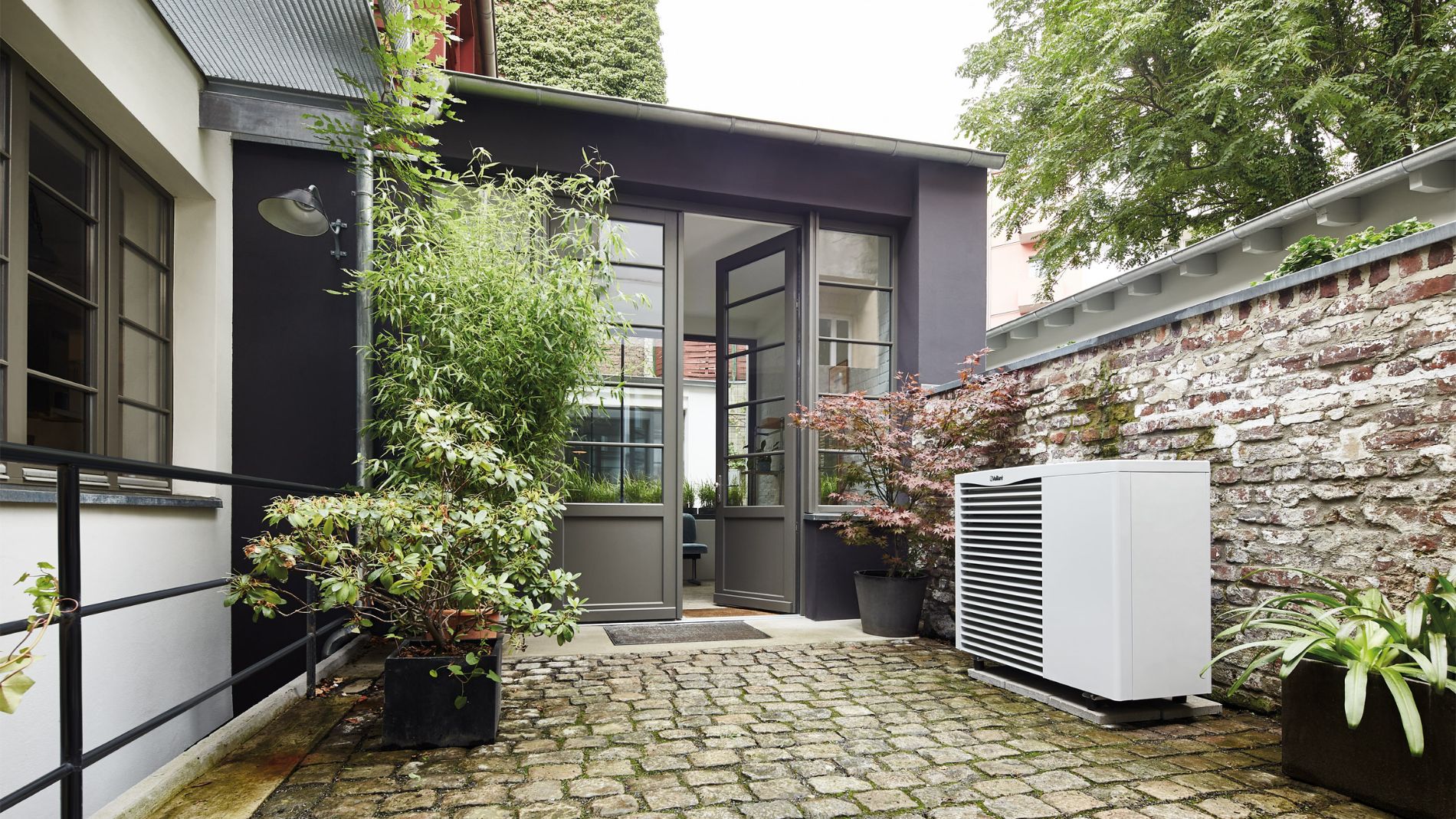Reading time: 6 minutes
The building sector plays a key role in enabling countries such as the Federal Republic of Germany to achieve their climate protection targets. It accounts for almost 40 per cent of total energy consumption and around one third of CO₂ emissions, making energy-efficient renovation and the switch to climate-friendly heating systems a decisive lever for decarbonisation. In order to increase the efficiency of the built environment in urban and rural areas, Germany first introduced the Energy Saving Ordinance (EnEV), followed by the Renewable Energies Heat Act (EEWärmeG). The EnEV 2014, which came into force under Angela Merkel's government, already pursued the ambitious goal of achieving a virtually climate-neutral building stock by 2050. The EnEV also institutionalised the energy performance certificate, which had to be presented when selling or renting a property. There were also requirements for existing properties, such as an obligation to replace heating systems installed before 1 January 1985. The EEWärmeG came into force on 1 January 2009 and was part of the German government's Integrated Energy and Climate Programme (IEKP). It introduced a nationwide obligation to use renewable energies in new buildings for the first time. Depending on the type of renewable energy, solar energy, biomass, geothermal energy or environmental heat, different minimum shares of 15 to 50 per cent were specified. Alternative measures, such as the use of waste heat or an increase in energy efficiency through insulation, were also permitted. The EnEV and EEWärmeG can thus be seen as cornerstones for regulating the building sector and promoting the heat transition.
The German Energy Efficiency Act (GEG) came into force on 1 November 2020 under Chancellor Angela Merkel (CDU). At that time, Horst Seehofer (CSU) was Minister of the Interior, Building and Community, Peter Altmeier (CDU) was Minister for Economic Affairs and Energy, and Svenja Schulze (SPD) was Minister for the Environment, Nature Conservation and Nuclear Safety. The GEG served to implement existing European directives with the aim of consolidating national climate protection targets in the building sector: it combined the Energy Saving Act, the EnEV and the EEWärmeG and included, among other things, a tightening of the replacement requirement for boilers. Systems that used liquid or gaseous fuels and were installed before 1991 now had to be replaced during renovation work, while newer boilers were subject to a 30-year deadline. Necessary but strategically cautious, the GEG is a prototypical law of the Merkel years. In an act of standardisation and simplification, existing regulations and provisions were consolidated instead of creating ambitious but potentially politically controversial new legislation. This avoided major domestic political disputes, and unpopular decisions on the necessary drastic acceleration of the heating transition were postponed to a later legislative period. Ultimately, it was a symbolic step that reaffirmed climate targets without, however, specifically addressing the necessary transformation of the heating market.
We‘ve come a long way, baby
Under the so-called ‘traffic light coalition’ of the SPD (red), FDP (yellow) and Greens, and with Olaf Scholz as Chancellor, the amendment to the GEG was passed in April 2023, sparking intense public and internal party debate that gave the law its colloquial name, the ‘Heating Act’. The original draft law provided for a ban on the installation of oil and gas heating systems in new and existing buildings from 1 January 2024, which led to fierce resistance. Heat pumps, a key technology in the necessary transformation process, became synonymous with high costs and state paternalism. These heat pumps draw energy from groundwater, the ground or the ambient air and use the heat thus obtained for heating and hot water. This scheme is the same for all types of heat pumps, even if the energy source differs, and is based on the same principle as a refrigerator, except that heat pumps generate heat instead of cold. Whereas a refrigerator extracts heat from its interior and dissipates it outside, a heat pump extracts heat from the environment outside the house and uses it to heat the living spaces.obligation for boilers. Systems that used liquid or gaseous fuels and were installed before 1991 now had to be replaced during renovation work, while newer boilers were subject to a 30-year deadline. Necessary but strategically cautious, the GEG is a prototypical law of the Merkel years. In an act of standardisation and simplification, existing regulations and provisions were consolidated instead of creating ambitious but potentially politically controversial new legislation. This avoided major domestic political disputes, and unpopular decisions on the necessary drastic acceleration of the heating transition were postponed to a later legislative period. Ultimately, it was a symbolic step that reaffirmed climate targets without, however, specifically addressing the necessary transformation of the heating market.
The key innovation in the amendment to the law announced in October 2023 was the so-called ‘65 per cent rule’, according to which every newly installed heating system must be powered by at least 65 per cent renewable energy. Because heat pumps run on electricity, they can easily be connected to solar systems. In addition, the GEG was linked to the Heat Planning Act (WPG), which was passed at the same time. This interlinking meant that the 65 per cent rule for existing buildings would only come into force after a municipal heat plan had been submitted. Large cities with a population of over 100,000 must submit their heat plans by mid-2026, while smaller cities must do so by mid-2028. This enabled owners of existing buildings to make their investment decisions based on concrete information about future heating networks or climate-neutral gas networks. New buildings in new development areas were exempt from this transition period and had to comply with the 65 per cent rule from 1 January 2024. So instead of enforcing a rigid, centrally imposed regulation, the ‘traffic light coalition’ launched a more flexible bottom-up approach that delegated decision-making on heat generation infrastructure to local authorities, allowing local conditions to be taken into account.
Heating hammer vs. bottom-up approach
In order to comply with the 65 per cent rule, citizens had various options available to them: connection to a heating network, electric heat pumps, solar thermal energy, biomass heating systems or hydrogen-compatible gas heating systems. Extensive funding was provided from the Climate and Transformation Fund: In addition to the basic subsidy of 30 per cent of investment costs for all homeowners, landlords, businesses and local authorities, which has been in place since the beginning of January 2024, various bonuses were introduced. In total, subsidies of up to 70 per cent of investment costs were possible. In addition, the law provided for hardship provisions that allowed exemption from the obligation to heat with renewable energies.
Since then, heat pump sales figures in Germany have served as a barometer for the effectiveness and communication of political framework conditions. They reflect political developments and the associated uncertainty or confidence of consumers in a remarkable way. In 2015, 31.4 per cent of all completed residential buildings were heated with a heat pump, making it the most common heating system after gas condensing boilers. Sales rose from 78,000 units in 2017 to 236,000 units in 2022, with 356,000 heating heat pumps sold in 2023. Experts attribute this growth to the so-called ‘pull-forward effect’, whereby many people quickly replaced their heating systems in order to pre-empt the installation ban originally planned for 2024. According to the German Heat Pump Association (BWP), sales of these units fell by 46 per cent to just 193,000 units in 2024. Uncertainty regarding municipal heating planning and the initial lack of awareness of the new subsidy programmes led to a noticeable sense of uncertainty among consumers, who postponed decisions on such investments.
Cancel or keep it?
During the 2024 election campaign and subsequent coalition negotiations, the Union formulated a plan to ‘abolish the traffic light coalition's heating law’. The coalition agreement of the black-red government echoed this sentiment by announcing the creation of a new building energy law that would be ‘more technology-neutral, flexible and simpler’. The law is intended to make ‘achievable CO₂ avoidance’ the central control variable. The focus should therefore be on less rigid requirements for specific heating systems, i.e. a results-oriented approach to the climate policy effects of the measures. At the same time, existing support instruments will be continued and an approach pursued in which heat supply is considered in the context of entire neighbourhoods, which suggests a pragmatic continuation of the compromise solutions already developed under the traffic light coalition.
The rhetorically loaded ‘Heating Act’ is thus formally ‘abolished’, while at the same time retaining those effective, less controversial control elements that were already agreed upon as a compromise in the late coalition phase. Despite this apparent reversal, the market for heat pumps is stabilising thanks to the amendment to the law in 2025 and the increasingly clear subsidy landscape. In the first quarter of 2025, sales rose by 35 per cent compared to the same period last year. Although the market for heat generators declined by 22 per cent in the first half of 2025 as a whole, sales of heat pumps rose by 55 per cent to 139,500 units. Heat pumps thus reached a new high with a market share of 47.0 per cent, while gas boilers fell to 44.7 per cent. The question of how to integrate the units, which surprisingly often stand in front of so-called owner-occupied homes, into the design remains almost completely unresolved. For the moment, their appearance seems at least as unsophisticated as that of the exposed aggregate concrete enclosures that were used in many places from the mid-1970s onwards in an attempt to find at least halfway decent coverings for the growing number of rubbish bins.












